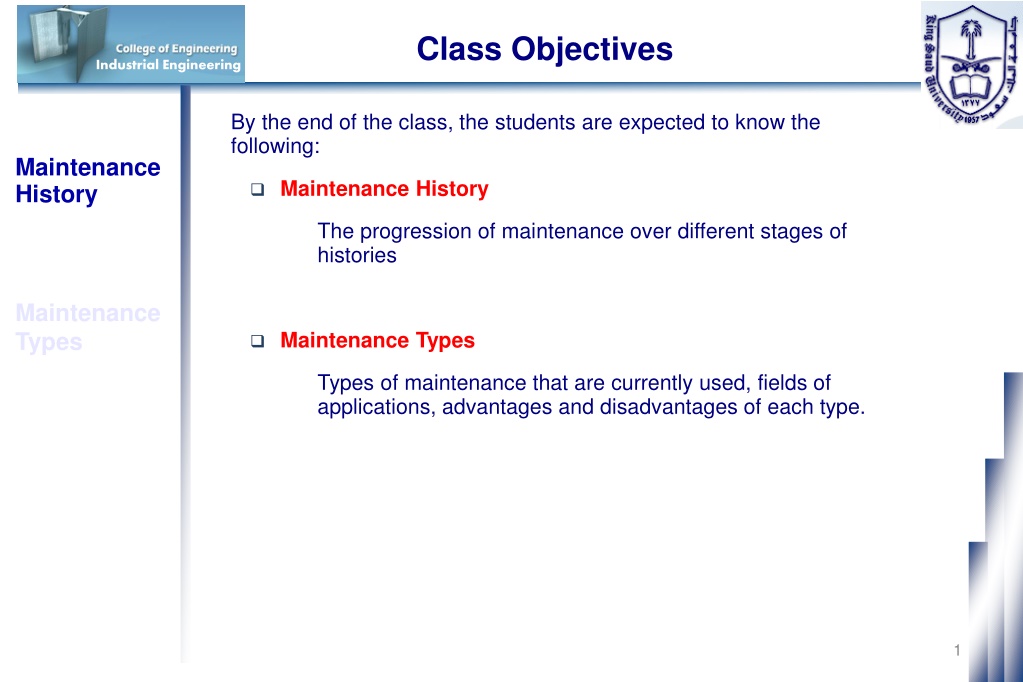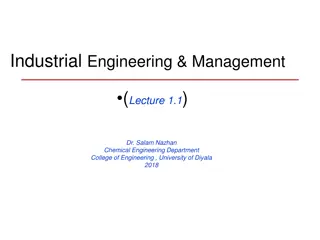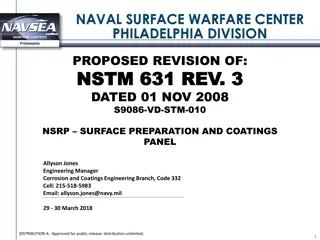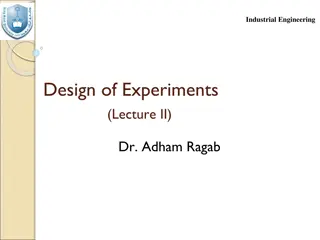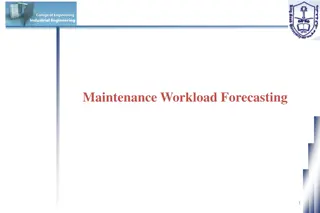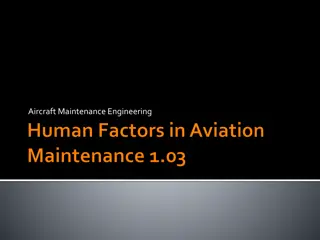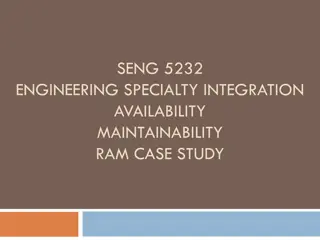Evolution of Maintenance in Industrial Engineering
Explore the historical progression of maintenance practices in industrial engineering, from being viewed as a cost burden to strategic asset management. Learn about different types of maintenance, their applications, advantages, and disadvantages. Gain insights into the activities involved in maintenance functions and how they contribute to operational efficiency while minimizing costs.
- Maintenance Evolution
- Industrial Engineering
- Maintenance Types
- Historical Progression
- Asset Management
Download Presentation

Please find below an Image/Link to download the presentation.
The content on the website is provided AS IS for your information and personal use only. It may not be sold, licensed, or shared on other websites without obtaining consent from the author. Download presentation by click this link. If you encounter any issues during the download, it is possible that the publisher has removed the file from their server.
E N D
Presentation Transcript
Class Objectives Industrial Engineering By the end of the class, the students are expected to know the following: Maintenance History Maintenance History The progression of maintenance over different stages of histories Maintenance Types Maintenance Types Types of maintenance that are currently used, fields of applications, advantages and disadvantages of each type. 1
Maintenance Definition Industrial Engineering Maintenance History British (3811:1993) defined maintenance as: Standard Glossary of terms Maintenance Types the administrative actions, including supervision actions, intended to retain an item in, or restore it to, a state in which it can perform a required function. combination of all technical and 2
Maintenance Definition Industrial Engineering Maintenance History maintenance is a set of organised activities that are carried out in order to keep an item in its best operational condition with acquired. Maintenance Types minimum cost 3
Maintenance Activities Industrial Engineering Maintenance History Activities of maintenance function could be either repair or replacement activities, which are necessary for an item to reach its acceptable productivity condition and these activities, should be carried out with a minimum possible cost. Maintenance Types 4
Maintenance History Industrial Engineering Maintenance History In the period of pre-World War II, people thought of maintenance as an added cost to the plant which did not increase the value of finished production. Maintenance Types Therefore, the maintenance at that era was restricted to fixing the unit when it breaks because it was the cheapest alternative. 5
Maintenance History Industrial Engineering During and after World War II at the time when the advances of engineering and scientific technology developed, people developed other types of maintenance, which were much cheaper such as preventive maintenance. Maintenance History Maintenance Types In addition, people in this era classified maintenance as a function of the production system. 6
Maintenance History Industrial Engineering Nowadays, increased awareness of such issues as environment safety, quality of product and services makes maintenance one of the most important functions that contribute to the success of the industry. Maintenance History Maintenance Types World-class companies are in continuous need of a very well organised maintenance programme to compete world-wide 7
Maintenance History Industrial Engineering Maintenance History -Term terotechnology introduced. -Recognition of need to present equipment failures. -Models for preventive maintenance developed. Maintenance Types Development of Maintenance -Increased awareness of: -Environment -Safety -Quality -Need for reliable equipment. -Reduction in costs. Fix the equipment when it breaks Time Pre-World War II Post-World War II 1980 Onwards Figure 2.2 Maintenance History (Adapted From Shenoy, Bhadury 1998) 8
Maintenance Objectives Industrial Engineering Maintenance objectives should be consistent with and subordinate to production goals. Maintenance History The relation between maintenance objectives and production goals is reflected in the action of keeping production machines and facilities in the best possible condition. Maintenance Types 9
Maintenance Objectives Industrial Engineering Maintenance History Maximising production or increasing facilities availability at the lowest cost and at the highest quality and safety standards. Maintenance Types Reducing breakdowns and emergency shutdowns. Optimising resources utilisation. Reducing downtime. Improving spares stock control. 10
Maintenance Objectives Industrial Engineering Maintenance History Improving equipment efficiency and reducing scrap rate. Minimising energy usage. Maintenance Types Optimising the useful life of equipment. Providing reliable cost and budgetary control. Identifying and implementing cost reductions. 11
Maintenance Objectives Industrial Engineering Maintenance History PLANT Maximising Production Reduce Breakdowns M A I N T E N A N C E Minimising Energy Usage Reduce Downtime Optimising Useful Life of Equipment Improving Equipment Efficiency Maintenance Types Providing Budgetary Control Improving Inventory Control Optimising Resources Utilisation Implementing Cost Reduction Figure 2.3 Maintenance Objectives 12
Maintenance Types Industrial Engineering Run to Failure Maintenance (RTF) Maintenance History Preventive Maintenance (PM) Corrective Maintenance (CM) Maintenance Types Improvement Maintenance (IM) Predictive Maintenance (PDM) 13
Maintenance Types Industrial Engineering Run to Failure Maintenance (RTF) Maintenance History The required repair, replacement, or restore action performed on a machine or a facility after the occurrence of a failure in order to bring this machine or facility to at least its minimum acceptable condition. It is the oldest type of maintenance and it is subdivided into two types: Maintenance Types Emergency maintenance: it is carried out as fast as possible in order to bring a failed machine or facility to a safe and operationally efficient condition. Breakdown maintenance: it is performed after the occurrence of an advanced considered failure for which advanced provision has been made in the form of repair method, spares, materials, labour and equipment. 14
Maintenance Types Industrial Engineering RTF Disadvantages Its activities are expensive in terms of both direct and indirect cost. Maintenance History Using this type of maintenance, the occurrence of a failure in a component can cause failures in other components in the same equipment, which leads to low production availability. Maintenance Types Its activities are very difficult to plan and schedule in advance. RTF Advantages The failure of a component in a system is unpredictable. The cost of performing run to failure maintenance activities is lower than performing other activities of other types of maintenance. The equipment failure priority is too low in order to include the activities of preventing it within the planned maintenance budget. 15
Maintenance Types Industrial Engineering Preventive Maintenance (PM) Maintenance History It is a set of activities that are performed on plant equipment, machinery, and systems before the occurrence of a failure in order to protect them and to prevent or eliminate any degradation in their operating conditions. The maintenance carried out at predetermined intervals or according to prescribed criteria and intended to reduce the probability of failure or the degradation of the functioning and the effects limited (British Standard 3811:1993 ) Maintenance Types It is good for those machines and facilities which their failure would cause serious production losses. Its aim is to maintain machines and facilities in such a condition that breakdowns and emergency repairs are minimised. Its activities include replacements, adjustments, major overhauls, inspections and lubrications. 16
Maintenance Types Industrial Engineering Factors Affecting Preventive Maintenance Maintenance History The need for an adequate number of staff in the maintenance department in order to perform this type of maintenance. The right choice of production equipment and machinery that is suitable for the working environment and that can tolerate the workload of this environment. Maintenance Types The required staff qualifications and skills, which can be gained through training. The support and commitment from executive management to the PM programme. The proper planning and scheduling of PM programme. The ability to properly apply the PM programme 17
Maintenance Types Industrial Engineering Preventive Maintenance (PM) Maintenance History Researchers subdivided preventive maintenance into different kinds according to the nature of its activities: Routine Maintenance which includes those maintenance activities that are repetitive and periodic in nature such as lubrication, cleaning, and small adjustment. Maintenance Types Running Maintenance which includes those maintenance activities that are carried out while the machine or equipment is running and they represent those activities that are performed before the actual preventive maintenance activities take place. Opportunity Maintenance which is a set of maintenance activities that are performed on a machine or a facility when an unplanned opportunity exists during the period of performing planned maintenance activities to other machines or facilities. 18
Maintenance Types Industrial Engineering Window Maintenance which is a set of activities that are carried out when a machine or equipment is not required for a definite period of time. Maintenance History Shutdown Preventive Maintenance, which is a set of preventive maintenance activities that are carried out when the production line is in total stoppage situation. Maintenance Types 19
Maintenance Types Industrial Engineering Maintenance History Maintenance Types 20
Maintenance Types Industrial Engineering Corrective Maintenance (CM) Maintenance History In this type, actions such as repair, replacement, or restore will be carried out after the occurrence of a failure in order to eliminate the source of this failure or reduce the frequency of its occurrence. The maintenance carried out after recognition and intended to put an item into a state in which it can perform a required function (British Standard 3811:1993 ) Maintenance Types 21
Maintenance Types Industrial Engineering Corrective Maintenance (CM) Maintenance History Corrective maintenance is subdivided into three types: Remedial Maintenance, which is a set of activities that are performed to eliminate the source of failure without interrupting the continuity of the production process. The way to carry out this type of corrective maintenance is by taking the item to be corrected out of the production line and replacing it with reconditioned item or transferring its workload to its redundancy. Maintenance Types Deferred Maintenance, which is a set of corrective maintenance activities that are not immediately initiated after the occurrence of a failure but are delayed in such a way that will not affect the production process. Shutdown Corrective Maintenance, which is a set of corrective maintenance activities that are performed when the production line is in total stoppage situation. 22
Maintenance Types Industrial Engineering Advantaged and Disadvantages of Corrective Maintenance (CM) Maintenance History The main objectives of corrective maintenance are the maximisation of the effectiveness of all critical plant systems, the elimination of breakdowns, the elimination of unnecessary repair, and the reduction of the deviations from optimum operating conditions. Maintenance Types The maintenance is that for the corrective maintenance, the failure should occur before any corrective action is taken. difference between corrective maintenance and preventive Corrective maintenance is different from run to failure maintenance in that its activities are planned and regularly taken out to keep plant s machines and equipment in optimum operating condition 23
Maintenance Types Industrial Engineering The way to perform corrective maintenance activities is by conducting four important steps: Maintenance History 1. Fault detection. Maintenance Types 2. Fault isolation. 3. Fault elimination. 4. Verification of fault elimination. In the fault elimination step several actions could be taken such as adjusting, aligning, calibrating, reworking, removing, replacing or renovation 24
Maintenance Types Industrial Engineering Improvement Maintenance (IM) Maintenance History It aims at reducing or eliminating entirely the need for maintenance. This type of maintenance is subdivided into three types as follows: Design-out Maintenance which is a set of activities that are used to eliminate the cause of maintenance, simplify maintenance tasks, or raise machine performance from the maintenance point of view by redesigning those machines and facilities which are vulnerable to frequent occurrence of failure and their long term repair or replacement cost is very expensive. 1. Maintenance Types Engineering Services which includes construction and construction modification, removal rearrangement of facilities. 2. and installation, and Shutdown Improvement Maintenance, which is a set of improvement maintenance activities that are performed while the production line is in a complete stoppage situation. 3. 25
Maintenance Types Industrial Engineering Predictive Maintenance (PDM) Maintenance History Predictive maintenance is a set of activities that detect changes in the physical condition of equipment (signs of failure) in order to carry out the appropriate maintenance work for maximising the service life of equipment without increasing the risk of failure. It is classified into two kinds according to the methods of detecting the signs of failure: Maintenance Types Condition-based predictive maintenance Statistical-based predictive maintenance Condition-based Predictive Maintenance depends on continuous or periodic condition monitoring equipment to detect the signs of failure. Statistical-based Predictive Maintenance depends on statistical data from the meticulous recording of the stoppages of the in-plant items and components in order to develop models for predicting failures 26
Maintenance Types Industrial Engineering The drawback of predictive maintenance is that it depends heavily on information and the correct interpretation of the information. Maintenance History Some researchers classified predictive maintenance as a type of preventive maintenance. Maintenance Types The main difference between preventive maintenance and predictive maintenance is that predictive maintenance uses monitoring the condition of machines or equipment to determine the actual mean time to failure whereas preventive maintenance depends on industrial average life statistics. 27
Maintenance Types Industrial Engineering MAINTENANCE Maintenance History PLANNED MAINTENANCE (PROACTIVE) UNPLANNED MAINTENANCE (REACTIVE) BREAKDOWN EMERGENCY Maintenance Types PREDECTIVE MAINTENANCE PREVENTIVE MAINTENANCE IMPROVEMENT MAINTENANCE CORRECTIVE MAINTENANCE STATISTICAL - BASED CONDITION - BASED DEFERRED REMEDIAL ENGINEERING SERVICES DESIGN - OUT Shutdown Maintenance WINDOW RUNNING ROUTINE OPPORTU- NITY SHUTDOWN PREVENTIVE SHUTDOWN IMPROVEMENT SHUTDOWN CORRECTIVE 28
Diagnostic Technologies Industrial Engineering The most commonly applied condition-based maintenance techniques are Vibration Analysis, Oil Analysis, Thermography, Ultrasonic, Electrical Effects and Penetrates. Diagnostic Technologies Vibration Analysis Vibration can be defined as the movement of a mass from its point of rest through all positions back to the point of rest, where it is ready to repeat the cycle. The time it takes to do this is its period, and the number of repetitions of this cycle in a given time is its frequency. Reliability Concepts The severity of vibration is determined by the amplitude - or maximum movement - its peak velocity and peak acceleration. Vibration analysis in condition monitoring, is accomplished by comparing vibration characteristics of current operation to a baseline, measured when the machinery was known to be operating normally. The selection of the specific parameters to be measured depends primarily on the frequency of the vibration. Examples 29
Diagnostic Technologies Industrial Engineering Vibration analysis techniques can be used to monitor the performance of mechanical equipment that rotates, reciprocates or has other dynamic actions. Examples include gearboxes, roller bearings, motors, pumps, fans, turbines, belt or chain drives, compressors, generators, conveyors, reciprocating engines and indexing machines Diagnostic Technologies Reliability Concepts Examples 30
Diagnostic Technologies Industrial Engineering Oil Analysis Ferrography and magnetic chip detection examine the iron-based wear particles in lubrication oils to determine the type and extent of wear, and can help determine the specific component that is wearing Diagnostic Technologies Spectrometric oil analysis measures the presence and amounts of contaminants in the oil through atomic emission or absorption spectrometry Reliability Concepts It is useful for determining not only iron, but also other metallic and not metallic elements, which can be related to the composition of the various machine components, like bearings, bushings, piston rings, etc. It is useful when wear particles are initially being generated in the early stages of failure, as they are small. Chromatography measures the changes in lubricant properties, including viscosity, flash point, pH, water content and insoluble, through selective absorption and analysis. Examples 31
Diagnostic Technologies Industrial Engineering Thermography The most common uses for thermography, which measures the surface temperature through the measurement of infra-red radiation, are for determining poor electrical connections and hot spots, furnace and kiln refractory wear and critical boiler and turbine component overheating. An infra-red camera shows surface temperature variations, calibrated to provide the absolute temperature or temperature gradients through black and white or color variations. Diagnostic Technologies Reliability Concepts Examples 32
Diagnostic Technologies Industrial Engineering Ultrasonic There are several techniques for ultrasonic testing, but they all are used to determine faults or anomalies in welds, coatings, piping, tubes, structures, shafts, etc. Cracks, gaps, buildups, erosion, corrosion and inclusions are discovered by transmitting ultrasonic pulses or waves through the material and assessing the resultant signature to determine the location and severity of the discontinuity. This technique is also used to measure flow rates. Diagnostic Technologies Reliability Concepts Examples 33
Diagnostic Technologies Industrial Engineering Electrical Effects Diagnostic Technologies There are several tests for corrosion using a simple electric circuit monitored by varying degrees of sophisticated instrumentation. One technique is based on the electro- chemical polarization method in a vessel with corrosive liquid, it uses the electrical resistance across a probe inserted in the active environment. Reliability Concepts The most common for monitoring or testing motors or generators are voltage generators, including mergers. These measure the resistance of insulation, and apply a test voltage from 250 volts to 10,000 volts. Examples 34
Diagnostic Technologies Industrial Engineering Penetrants Diagnostic Technologies Electrostatic and liquid dye penetrants are used to detect cracks and discontinuities on surfaces, caused in manufacturing, by wear, fatigue, maintenance and overhaul procedures, corrosion or general weathering. Reliability Concepts The penetrant is applied and allowed to penetrate into the anomalies. The surface is cleaned and the penetrant revealed through direct visual, fluorescent or electrostatic techniques. Examples 35
Diagnostic Technologies Industrial Engineering AC Motor Example Condition Based Maintenance Diagnostic Technologies CBM Indication Cause Detection Parameters Sensor High Overall Vibration Level [A] Improper Bedplate or Foundation Design or Construction [B] Defective or Improperly Installed/Maintained Motor Mounts [C] Misalignment with Driven Equipment Vibration Accelerometer Reliability Concepts High Frame Temperature [A] High Rotor Bearing Temperature [B] High Stator Winding Temperature [C] High Ambient Temperature Temperature RTD, Thermistor High Rotor Bearing Temperature [A] Over-greased [B] Under-greased [C] Excessive Bearing Wear Temperature RTD, Thermistor Examples Low/High Current at Motor [A] Low/High Line Current [B] Motor Controller Failure Current Reading Current Low Torque [A] Low Voltage [B] Dropped Load Torque/Voltage Torque /Voltage Phase Imbalance [A] Line Voltage Imbalance Phase Reading Phase 36
